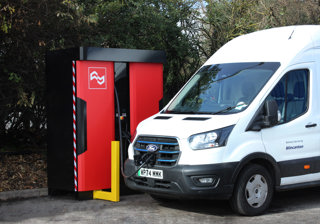This feature was taken from our Electric Fleet: Moving to Net Zero special report.
![]()
Technology and legislation evolves rapidly in the developing electric vehicle sector. We highlight four potential changes which will impact fleets:
1 Battery health
Calls are continuing from the automotive sector to introduce battery health certificates for electric vehicles (EVs), with the aim of giving confidence in the technology to used car buyers as well as better inform residual value setters.
Under its Plan for the Automotive Sector, published in October 2023, Labour pledged to introduce a standardised battery health certificate for used EVs.
The Government has also helped the UN develop a global technical regulation on United Nations Global Technical Regulation Number 22 on EV batteries (GTR 22), says Abdul Chowdhury, head of vehicle policy at the Office for Zero Emission Vehicles (OZEV).
“GTR 22 provides the requirement for a battery state of health monitor which is in an easily accessible manner, such as through the vehicle’s dashboard, so, essentially, you get a battery health figure like you do on your iPhone,” he adds.
“It also details minimum performance standards for EV batteries, which have already been incorporated into UK regulations through the ZEV Mandate’s warranty requirements.
“Secondly, the regulations also mandate that the batteries need minimum performance standards so they are not degrading quicker than they should.
“Historically, the mileage of a vehicle was a strong indicator for its life expectancy and you could examine an engine to see if the head gasket was about to go, for example.
“Obviously, you can’t do that in the same way for a battery and that’s where there could be a role for things like battery health certificates to help correctly assign a value for the vehicle.”
In research published last month telematics provider Geotab analysed the battery health of almost 5,000 fleet and private EVs, representing nearly 1.5 million days of data, and found batteries degrade, on average, by 1.8% per year.
This compares with 2.3% when it last performed a wholesale analysis of EV battery health in 2019. It found batteries in high-use EVs did not show significantly higher battery degradation than in lower use vehicles.
David Savage, vice-president for the UK and Ireland at Geotab, says: “With these higher levels of sustained health, batteries in the latest EV models will comfortably outlast the usable life of the vehicle and will likely not need to be replaced.
“The fact is that a 1.8% decline in battery health is unlikely to have a significant impact on most drivers’ daily vehicle needs, and this number will only come down further with new EV models and improved battery technology.”
Battery degradation is a natural process that permanently reduces the amount of energy a battery can store or the amount of power it can deliver.
2 Battery chemistry
The traction battery is essentially the heart of an EV – it is the single most expensive component and also has a critical bearing its operation, having a huge influence on factors such as range and charging speeds.
Currently, all production EVs sold in the UK use lithium-ion chemistry, but different manufacturers may choose different ingredients for their battery cells.
For example, lithium nickel manganese cobalt oxide (NMC) is one of the most popular chemistries, but many manufacturers are looking to reduce their use of nickel and cobalt – therefore cutting costs – in their batteries, or switching to alternatives such as lithium-ion phosphate (LFP).
The share of LFP batteries in EV sales remains below 10%, with high-nickel chemistries still most common, says the International Energy Agency.
“Further declines in battery cost and critical mineral reliance might come from sodium-ion batteries,” it adds. “The need for critical minerals like nickel and manganese for sodium-ion batteries depends on the cathode chemistry used, but no sodium-ion chemistries require lithium.”
However, for many experts solid-state batteries are the Holy Grail for EVs as they offer greater range, faster charging times and increased safety over lithium-ion units.
The major advantage they have is that they use solid electrolytes as opposed to liquid. In practical terms, this gives them a greater energy density which means they can hold anywhere between two to 10 times the energy of a similar-sized lithium-ion battery.
They will also charge faster as the solid electrolyte will not suffer the same over-heating issues as the liquid electrolytes in lithium-ion batteries. Degradation will also be lower.
Furthermore, as solid-state batteries do not have the flammable liquid electrolytes of a lithium-ion battery, they also have a much lower risk of fire.
“The rollout of DC ultra-fast charging, combined with solid-state batteries, could allow us to move to a situation where the recharging of the battery can be much more akin to the petrol station experience by really cutting down on those charging times,” says Jonathan Davenport, senior director analyst at technology analysts Gartner.
Car manufacturers are keen to adopt the technology, with Toyota, Nissan, Volkswagen and Mercedes-Benz all known to be developing it.
Mercedes-Benz, for example, expects its next-gen batteries to go into production for passenger vehicles by 2030, with Nissan setting a date of 2029.
“We are finally in the phase of scaling up on our solid-state battery line,” says Shunichi Inamijima, corporate vice-president at Nissan.
“Our solid-state battery technology is a game-changer for making EV sales grow explosively.”
3. Plug-and-charge
Under plug-and-charge, an EV driver will simply be able to plug their vehicle into a charge point and the two will automatically process payment information: no payment cards or apps will be needed.
It uses standard ISO 15118, which is a new form of encrypted communication between an EV and a charge point, and involves asymmetric cryptography: a pairing of public and private security keys, neither of which can be decrypted without the other.
This allows for a high degree of data security and integrity, and means that once an EV owner has set up their payment and authentication information, everything else is taken care of.
“Plug-and-charge will really simplify things for fleets,” says Jonathan Davenport, senior director analyst, of technology analysts Gartner.
Tesla developed its proprietary version of plug-and-charge 10 years ago. Octopus Electroverse also offers access to the technology, although this is limited to a small number of Volkswagen Group cars and BMWs on just the Ionity charging network.
Gartner expects the technology will enter the mainstream within the next five to 10 years.
Davenport says one potential obstacle to this is the current dominance by existing large credit card/payment providers that have brand awareness and who may feel their market presence may be threatened by the advent of an alternative payment solution.
4 Wireless charging
A second trial of electric vehicle wireless charging is currently underway in the Midlands, further investigating the feasibility and effectiveness of the technology.
Being led by Coventry University and Coventry City Council, in collaboration with Cenex, the Dynacov – short for dynamic charging of vehicles - initiative uses a coil implanted just below the road surface that establishes a connection with vehicles and charges them wirelessly as they drive over.
The technology could be deployed for buses and logistics vehicles, says the university. “Solutions like this will enable the transition to electric vehicles to happen more quickly,” adds Jim O’Boyle, Coventry City Council’s cabinet member for jobs, regeneration and climate change.
The project is being funded by National Grid Electricity Distribution and is focused on a section of Kenilworth Road at its junction with the A45. If successful, it is hoped this project will attract Government support and funding to further develop the technology.
Coventry University was also involved in the Wireless Charging of Taxi (WiCET) trial in Nottingham, which ran for four months and ended in January last year.
This saw a fleet of electric and range-extender taxis wirelessly charge using five 11kW induction charging pads installed in the ground in the taxi rank in Trent Street, outside the central railway station, while they were stationary and waiting for their next fare.
Nine vehicles - five LEVC TXs and four Nissan eNV200 Dynamo taxi conversions – were modified so they could charge when the driver, using the guidance of an HMI screen in the cabin, aligned their vehicle over a ground pad.
The system was able to differentiate between cars and the appropriate drivers were then billed through a web-based app, meaning they did not have to leave their cars at all during the charging process.
The wireless charging system achieved 90% power transfer efficiency, which makes it comparable with plug-in chargers.
“The charging facility was aimed at top-up charging rather than being a replacement for plug-in charging,” says Richard Sander, technical consultant and project manager at Cenex, which led the initiative.
He likens this approach to ‘grazing’, where the battery is kept at a consistent state of charge instead of running the battery down and then recharging fully.
Overall findings showed wireless charging works and would have numerous benefits for many fleets, says Sander.
“Some benefits will be very obvious, some less so,” he adds. “It’s very easy to use once the driver is used to it.
“They drive up, line up and the EV starts charging until they drive away. It avoids having any cables lying around which can get damaged or be trip hazards, so it’s perfect for operational working areas.
“There are not any exposed electrical contacts, so it’s well suited to dirty environments; there are no moving mechanical parts, so there is less wear and tear.
“There is the potential to deploy it with minimal or no street furniture/hardware on the charging site, and if you can deploy it for top-up charging you could potentially reduce the size and weight of the propulsion battery within the vehicle.”
Decarbonising a fleet is not just about replacing an ICE vehicle with a like-for-like electric replacement – it may open the door to other, more operationally efficient transport modes.
In our new Electric Fleet: Moving to Net Zero special report, we look at the fleets that are already utilising flying drones, rolling robots or powered mobility such as e-cargo bikes and light vehicles, assessing use cases and considerations for organisations looking to pilot these options.
We also look ahead to forthcoming battery electric technology to evaluate its potential impact on fleet operations, with longer ranges and faster charging among the key benefits, as well as the potential of hydrogen, which is undergoing a number of Government-funded trials in the UK.
Other topics we investigate include the ongoing impact of the ZEV Mandate and how fleet managers need to be prepared to take advantage of any potential deals offered by manufacturers, and technology trends – including batteries – which will have an influence on fleet operations.
We also look at what fully-electric cars will hit the UK market over the next 12 to 18 months, some of which will offer a WLTP range of more than 400 miles.

























Login to comment
Comments
No comments have been made yet.